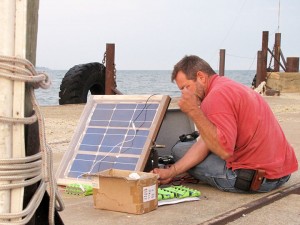
Gregg Stephens on the Firelands Winery dock last year with his homemade solar panel setup. The green round items are the individual cells of his battery packs, which he also made. Hams call constructing one’s own equipment “home brewing.”
Over the past year, the news has been full of reports of amateur radio operators, often called “hams,” providing critical communications during unexpected emergencies in towns across America, including the California wildfires, winter storms, tornadoes and other events world-wide. This weekend, June 28-29, the public will have a chance to meet and talk with ham radio operators and see for themselves what the Amateur Radio Service is about, as hams across the USA will be holding public demonstrations of emergency communications abilities.
This annual event, called “Field Day,” is the climax of the week long “Amateur Radio Week” sponsored by the American Radio Relay League (ARRL), the national association for Amateur Radio. Using only emergency power supplies, ham operators will construct emergency stations in parks, shopping malls, schools, and backyards around the country. Their slogan, “When All Else Fails, Ham Radio Works,” is more than just words to the hams, as they prove they can send messages in many forms without the use of phone systems, Internet or any other infrastructure that can be compromised in a crisis.
Despite the Internet, cell phones, email and modern communications, every year whole regions find themselves in the dark. During these times, ham radio operators provide backup communications for everyone from the American Red Cross to the Federal Emergency Management Administration (FEMA) and even for the International Space Station.
“The fastest way to turn a crisis into a total disaster is to lose communications,” said Allen Pitts of the ARRL. “From the earthquake and tsunami in Japan to tornadoes in Missouri, ham radio provided the most reliable communication networks in the first critical hours of the events. Because ham radios are not dependent on the Internet, cell towers or other infrastructure, they work when nothing else is available. We need nothing between us but air.”
More than 35,000 amateur radio operators across the country participated in last year’s event.
The event this year will run from 2:00 p.m. Saturday to 2:00 p.m. on Sunday.
The Marion Amateur Radio Club will be participating at the northeast corner of State Route 309 and Pole Lane Road (the old Army Reserve building, now part of First Consolidated Fire District). Local hams will be on hand demonstrating different types of radios and set up showing the various ways emergency communications can be handled.
The event is free to the public and visitors can get a hands-on experience with amateur radio. You’ll even have a chance to talk with people at other field stations around the country and the world.
If you enjoy what you learn, volunteers will even be able to show you how you can get started in this potentially life-saving hobby.
In addition to the local activities, three “hams” from Marion and Cardington are hitting the road. Kenny Snare, Greg Stephens, and Grant Powell will be operating from the Firelands Winery private dock at North Bass Island with a special amateur radio station call sign, N8B, issued by the Federal Communications Commission specifically for this event.
The three will be operating completely from batteries with solar panels. Stephens will be using “advanced technology storage cells,” while the other two will be using lead-acid technology. Stephens said his cells worked “marvelously” last year and he built his own solar panel setup.
Amateur Radio is growing in the United States. There are now over 700,000 Amateur Radio licensees in the U.S., and more than 2.5 million around the world. Through the ARRL’s Amateur Radio Emergency Service program, ham volunteers provide both emergency communications for thousands of state and local emergency response agencies and non-emergency community services too, all for free.
To learn more about Amateur Radio, go to www.emergency-radio.org.


